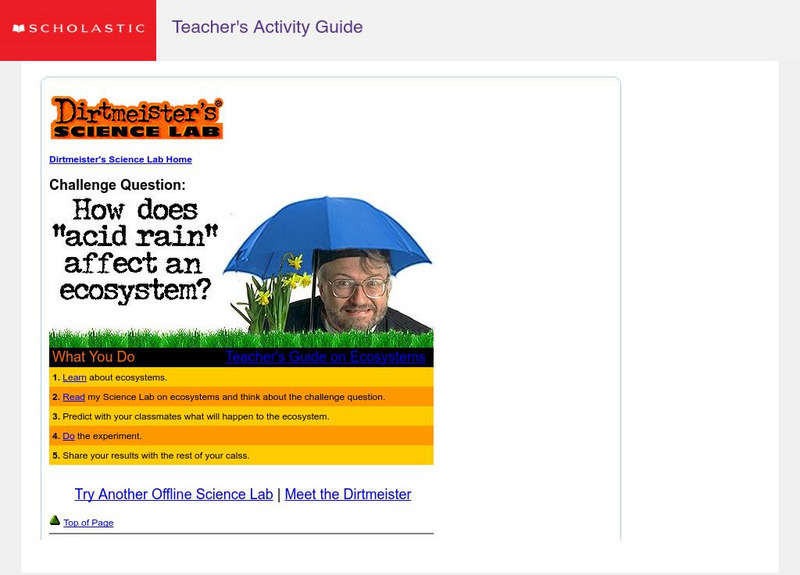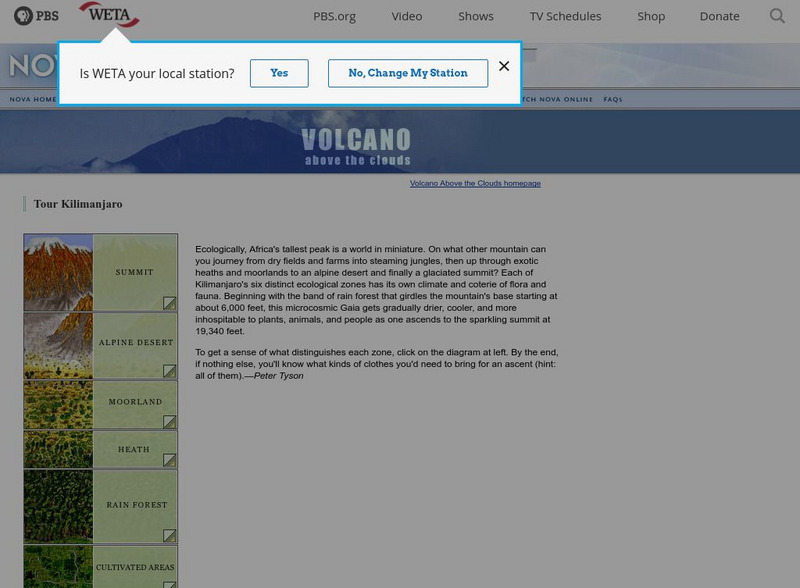Missouri Botanical Garden
Missouri Botanical Garden: Biology of Plants: Plant Adaptations
Read about how plants adapt to survive in different biomes. Includes a song, game, photos, and lesson plans.
National Earth Science Teachers Association
Windows to the Universe: Climate Changes With Latitude
A map showing the division of the world into eight biomes based on different climate types around the world. There are links to more information about each biome.
Everything ESL
Everything Esl: Forest, Deserts and Grasslands
Biomes and Ecosystems unit will increase the interest of the ELL students. Lessons are based on the TESOL, ESL standards.
Alabama Learning Exchange
Alex: Abc Book of Fauna
This lesson is to provide students the opportunity to explore the various types of fauna (animals) found in the various biomes throughout the world.
Scholastic
Scholastic: Dirtmeister's Science Lab: Acid Rain
Step into Dirtmeister's Science Lab as he sets out to answer the challenge question: "How does acid rain affect an ecosystem?" Learn about ecosystems, make your predictions and then do the experiment.
Alabama Learning Exchange
Alex: Making and Observing Life in a Terrarium
For this lesson, the students will learn what a terrarium is, the layers of a terrarium, and the function of these layers. They will see how these components work together to create an ecosystem. This lesson plan was created as a result...
PBS
Nova: Tour Kilimanjaro
Experience six different ecological zones as you climb Mt. Kilimanjaro. Pictures of plants living in each of the zones are also part of this virtual tour of the mountain.
ClassFlow
Class Flow: Identify the Animal and Its Biome
[Free Registration/Login Required] Each page contains a hidden picture of an animal. Students use a small viewer to expose small pieces of the picture.
Science Education Resource Center at Carleton College
Serc: Interdependence of Life: How an Ecosystem Responds to Change
In this biology field investigation, learners will investigate the site of an environmental disturbance, identify plant and animal life within that specific area, and compare it to an adjoining forested area. Students will map both areas...
TeachEngineering
Teach Engineering: Biodomes
Students explore the biosphere's environments and ecosystems, learning along the way about the plants, animals, resources and natural cycles of our planet. Over the course of lessons 2-6, students use their growing understanding of...
Virginia Tech
Virginia Tech Univ: The Forest Community
Describes the complexity of a forest ecosystem. Pine forest succession. Role of fungi in the forest. Photos, examples.
University of Michigan
University of Michigan: Global Change: The Flow of Energy: Higher Trophic Levels
This lesson addresses the following questions: What is the efficiency with which energy is converted from trophic level to trophic level? What are the differences between assimilation efficiency, net production efficiency, and ecological...
Other
Pde Sas: Relationships Among Organisms
In this lesson, young scholars compare various types of relationships among organisms (i.e., biotic interactions). Students will: explain the roles of producers and consumers, and predators and prey in an ecosystem. Explain the levels of...
Annenberg Foundation
Annenberg Learner: The Habitable Planet: Ecology Lab
Create the parameters of your own ecosystem by choosing which producers and consumers live there. Visualize how the food web operates and species populations change. This simulator mimics the food web within a typical ecosystem and gives...
CK-12 Foundation
Ck 12: Episd Biology: Flow of Energy
[Free Registration/Login may be required to access all resource tools.] Students will study how energy flows through an ecosystem and learn about photoautotrophs and chemoautotrophs, the role of decomposers, and of consumers.
United Nations
Unesco: Canada: Biosphere Reserves
Lists sixteen biosphere reserves in Canada that have been designated as such by the United Nations Educational, Scientific and Cultural Organization. Each ecosystem is described, along with ecological and socio-economic characteristics...
TeachEngineering
Teach Engineering: Working Together to Live Together
Students experience civil and environmental engineering by planning a housing development in an existing biome, while also protecting the native species that live there. They conduct research, draw plans, make brochures and give...
NOAA
Noaa: National Ocean Service Education: Estuaries
Illustrated tutorial explains estuary ecosystems. Animations and illustrations help students become more familiar with the plant and animal communities which make up this coastal habitat.
PBS
Pbs: Nature: Hawaii's Vulnerable Biodiversity
Because of Hawaii's isolation, endemic species evolved in their own unique way. With the arrival of foreigners and colonization, new species were introduced to the islands. The result being a crisis within the Hawaiian ecosystem,...
Utah State Office of Education
Utah Science: What Do You Mean, We Are Different?
Across the state of Utah one will observe a variety of environments such as wetlands, desert, and forest. Here are several activities highlighting the many ecosystems found within one state.
Other
Ohio Department of Education: The Long and Short Story of Ecological Succession
An ecology simulation where each student plays a role of an organism in an forest ecosystem. Students earn and keep track of their own survival points to determine which type of organism is most successful at survival during different...
Other
Thurston High School: Tundra Project
High school student site that describes and illustrates the tundra biome with such topics as climate, location, vegetation, health issues, and animals.
PBS
Nova: Explore Madagascar
This resource is a nice overview of Madagascar. Explore the organisms, habitats and geography of Madagascar. Plenty of pictures as well as 360 degree panoramic views make it worth investigating.

























